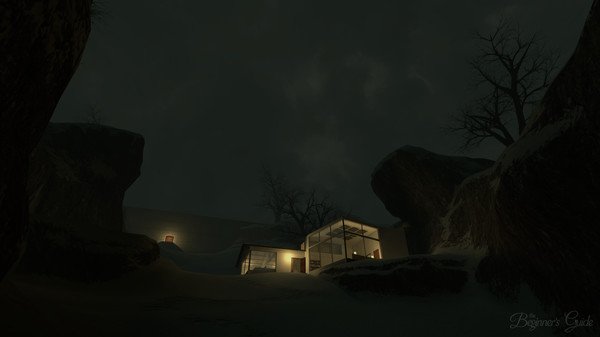How to lose friends and alienate coda.
One of the largest contributing factors in perpetuating a sense of hopelessness in sufferers of depression and anxiety is the feeling that they’re letting others down due to their disorder. This common perception leads to those suffering feeling a tremendous amount of unwarranted guilt when they hit their lowest points.
Will my friends and family think I’m an awful person if I shun my adult responsibilities in order to stay in bed for the majority of this week? Will I let people down if I cancel all my plans for the foreseeable future because I don’t feel mentally well? Will everyone shut me out of their lives because they think I’m doing the same to them? These are intrusive questions that, rather than encouraging those debilitated by their illness to try to overcome the hurdles blocking their path, instead convinces them that they’d be better off retreating deeper into their cocoon.
The Beginner’s Guide is the most autobiographical game I have ever played, and its brutal honesty in conveying the intrusive thoughts of its creator is at once admirable and discomfiting. Developed by The Stanley Parable co-creator Davey Wreden, The Beginner’s Guide sees Wreden providing narration as he guides you through a series of abstract, postmodern games developed by his mysterious friend known only as “Coda.” Beginning with a custom Counter-Strike map, Wreden informs the player that Coda’s short games tell us a lot about the man who made them, and as such he spends the entirety of The Beginner’s Guide offering his opinions on the perceived symbolism included in them.
Wreden’s voice over is devoid of the dark humor he injected into The Stanley Parable through that game’s narrator, and the informality of it makes you fully aware that you are an individual playing a game, rather than an individual who is assuming the role of a character in a game’s world. While The Stanley Parable broke the fourth wall, in The Beginner’s Guide the fourth wall doesn’t exist, with your role being that of a player of a game and not a player-character.
Wreden points out design choices made by Coda at every turn, making a note of recurring themes and shifts in tone, before connecting the dots between their inclusion and Coda’s mindset at the time of their creation. A door-based puzzle is emblematic of Coda opening and closing different chapters of his life, while a prison is a metaphor for his social anxiety, according to Wreden. Plenty of it is Psychology 101, and its frequent lack of subtlety makes the game’s concepts easier to digest than you would expect, but each new small revelation about Coda serves to make him a more intriguing character who I wanted to learn more about. It’s perhaps the only game in existence where its designer is the protagonist rather than the player.
While similarities can easily be drawn between both of Wreden’s creations, with them both being meta-heavy, narrative-focused “walking simulators,” they are different beasts. The Stanley Parable’s plot revolves around player agency in video game design (and in life itself), while The Beginner’s Guide focuses upon a more personal story, and its effectiveness will invariably rest upon whether or not you are open to hearing this kind of tale conveyed in a video game.
I admit that I struggled with it, as there is something quite jarring about listening to Wreden providing narration for his own game, even though he’s essentially playing a character within it. The praise he heaps upon much of Coda’s work feels self-congratulatory when you disconnect yourself from its story and consider that Coda is a fictional character, with it often feeling like you’re playing through the video game equivalent of a commentary track on a Director’s Cut Blu-ray, only with the director in question lacking any semblance of humility.
But that’s kinda the point. The Beginner’s Guide flirts with a potentially pretentious concept, but as it opened itself up more to me I began to realize that it needed to do so in order to successfully convey its message. While that message is tied into an end-game reveal that I cannot articulate without spoiling it for anyone who wishes to play it, I will say that it does feature a tonal shift that significantly shakes things up. Prior to this reveal taking shape I began to feel weary of Wreden pointing at things and telling me how they made him feel, but by the time the game had reached its conclusion I was confident that I had just experienced one of the bravest pieces of storytelling in this medium.
However, regardless of how daring the game is, I still found it to be less engaging than Davey Wreden’s previous work. In The Stanley Parable, he told an all-encompassing story that had a little something for everyone. Depending upon which of its branching paths you chose to venture down you could find yourself being told a tale of protagonist Stanley plunging into psychosis, or a critique on the mundanity of modern life, or a deconstruction of video game design. On the other hand, The Beginner’s Guide tells one very specific story, and as such I found it less affecting on a personal level.
The Stanley Parable was staggeringly accomplished at veering wildly into a range of different emotions, with its sharp dialogue allowing it to switch between genuine laugh-out-loud moments to pointed critiques without ever feeling overwrought. But despite The Beginner’s Guide’s multitude of levels presenting a new concept at every turn, the game beneath them remains the same. You’re doing little more than walking around and looking at things, and without the interactive narrative of The Stanley Parable, I found The Beginner’s Guide to be an experience that shares more in common with the likes of Gone Home and Dear Esther than Wreden’s previous masterpiece.
While that isn’t a bad thing in and of itself, as Gone Home in particular proves that a “walking simulator” could manage to keep players engaged with its story through dialogue and atmosphere alone, The Beginner’s Guide is essentially a guided tour of someone else’s mind where you’re led down a linear path and are told to look at objects and exactly how you should be looking at them. This becomes less apparent during the game’s closing moments, where you’re piecing together the puzzle of Coda and Wreden’s relationship, but considering the game is so short in length (it clocks in at around 2 hours), I spent much of its first half feeling disengaged from what was taking place around me.
Pacing issues aside, though, there are many who will love The Beginner’s Guide for so unabashedly conveying the insecurities of its creator, and for its warts and all portrayal of mental health issues. Despite my own reservations about how effectively these subjects are tackled, how successful it is will inevitably differ from person to person, and will depend upon how greatly you empathize with its subject matter. As such, if you’re a fan of Davey Wreden’s work or simply wish to see these themes tackled in a video game, then I’d recommend giving it a shot. At the very least, The Beginner’s Guide will provide you with an experience unlike anything else in the medium.
-
An incredibly honest deconstruction of its creator
-
A conclusion that will have you still piecing together the puzzle after the credits roll
-
One of the bravest pieces of storytelling ever featured in a video game
-
Pacing issues negatively impact upon the first half of the game
-
Its “guided tour” gameplay style causes a disconnect between the player and the games
the-beginners-guide
-
the-beginners-guide #1

-
the-beginners-guide #2

-
the-beginners-guide #3

-
the-beginners-guide #4

-
the-beginners-guide #5

-
the-beginners-guide #6












